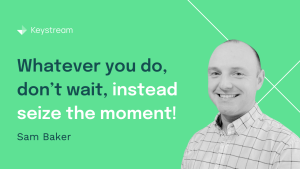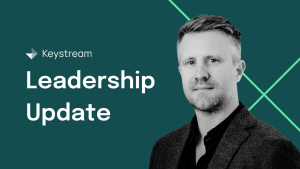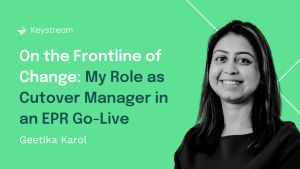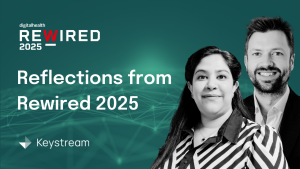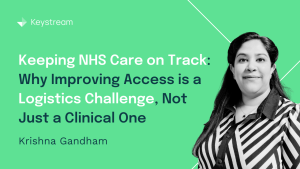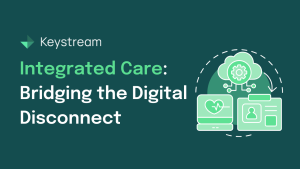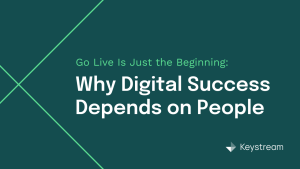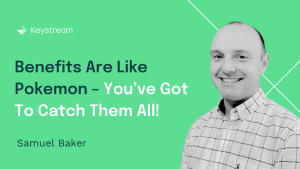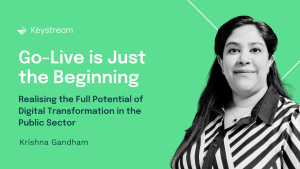01.06.2021
The Right Kind of Loud – Training at Keystream Analytics
What is The Right Kind of Loud all about?
Recently Keystream Analytics had the opportunity to host Kim A. Page for a workshop where she guided us through the journey of finding our communication voice. Kim’s work is dedicated to helping you find the Right Kind of Loud, raising your impact and influence in the corporate world and increasing your personal power.
Move Right
Body Language
Presence & Confidence
Listen Right
Active Listening Method
Sound Right
Voice Theory Exercises
Tell it Right
Finding Your Writing Voice
Move Right: body language – presence and confidence
We call it executive presence or owning the room. It starts with feeling comfortable in our own skin. And as Kim says, there’s a method behind the magic. We learnt how to distinguish and analyse body signals by doing exercises with status markers (high vs low status) and aligning different types of body language with different communication approaches.
This led us to gain more confidence and ease, supporting the message we were trying to convey.
Listen Right: active listening method
In a recent article in Forbes, research showed that this generation struggles to listen without hearing or understanding the point a person is trying to make while they’re presenting or engaging in a conversation. Instead, we are often waiting to express our own opinions at the first opportunity. This leads us to miss important information and miscommunication is created.
Step by step active listening method:
- Pay attention to the meaning of what the other speaker is saying. Pay attention to body language.
- Let no meaning escape you: clarify, summarise, paraphrase.
- When you notice that your mind has wandered, instantly return to the speaker’s meaning and body language. Do this as often as necessary.
- Pay attention to what you say – as you say it – not before you say it. Do no rehearse your next remark.
Eventually, by practicing active listening method, we were able to:
- Improve the ability of maintaining focus while listening
- Make each one of us heard in conversations and during discussions
- Approach and attaining agreement during difficult situations
Sound Right: voice theory and exercises
When speaking to others your tone can affect not only how people perceive you but also their willingness to listen to you – especially in the workplace. It plays a huge role in productivity; it impacts how employees see each other and it might even lead to damaging overall morale and engagement. In short, the tone of voice has a substantial impact on how our message is received on the other end.
During this module, Kim engaged us with voice training. This improved our vocal confidence by:
- connecting our voices with our bodies
- exploring vocal range and sound qualities, enabling vocal variety
- projecting our voices without strain and reaching the audience

Tell it Right: finding your writing voice
According to Kim, all of us carry stories inside but we don’t always know how to get them down on paper. In this module, we learnt how to get started, how to awaken word wonder and make our texts come alive. Our challenge was to write about two topics non-stop and let our creative minds flow from the tip of our pen. We were encouraged to dive deep and use details and senses, include foreign words and ignore grammar and spelling.
These were our takeaways:
- awareness of stylistic tools and literary genres
- increased textual awareness of form and content
- new/renewed access to our unique writing voice
Speak Right
Presentation Tools, Storytelling and Audience Connection
Connect Right
Reflecting On Training Journey
Speak Right: presentation tools, storytelling and audience connection
In the corporate world, giving presentations is part of daily work life for many employees. Indeed, presentation skills are critical for promotions and career success. However, the ability to connect with an audience and keep them engaged is far from easy. Starting out, Kim invited us to reflect on what makes a presentation good. Some of the tools are: eye contact, body language, tone of voice (volume), pauses (speed), being relaxed, simplicity – less is more, authenticity, audience interaction and warmth.
We were given guidelines on:
Throughout the Speak Right module we developed our credibility and ability to capture the attention of the listeners. We were able to fit in 27 different stories, allowing us to reflect on our presentation skills while slowly building confidence and ease in front of the audience.
In the last module we looked back at our presentations, making observations and receiving feedback from Kim about our personal strengths and stretching areas as speakers. Applying all the tools from our Right Kind of Loud journey, these are the pointers we worked with:






